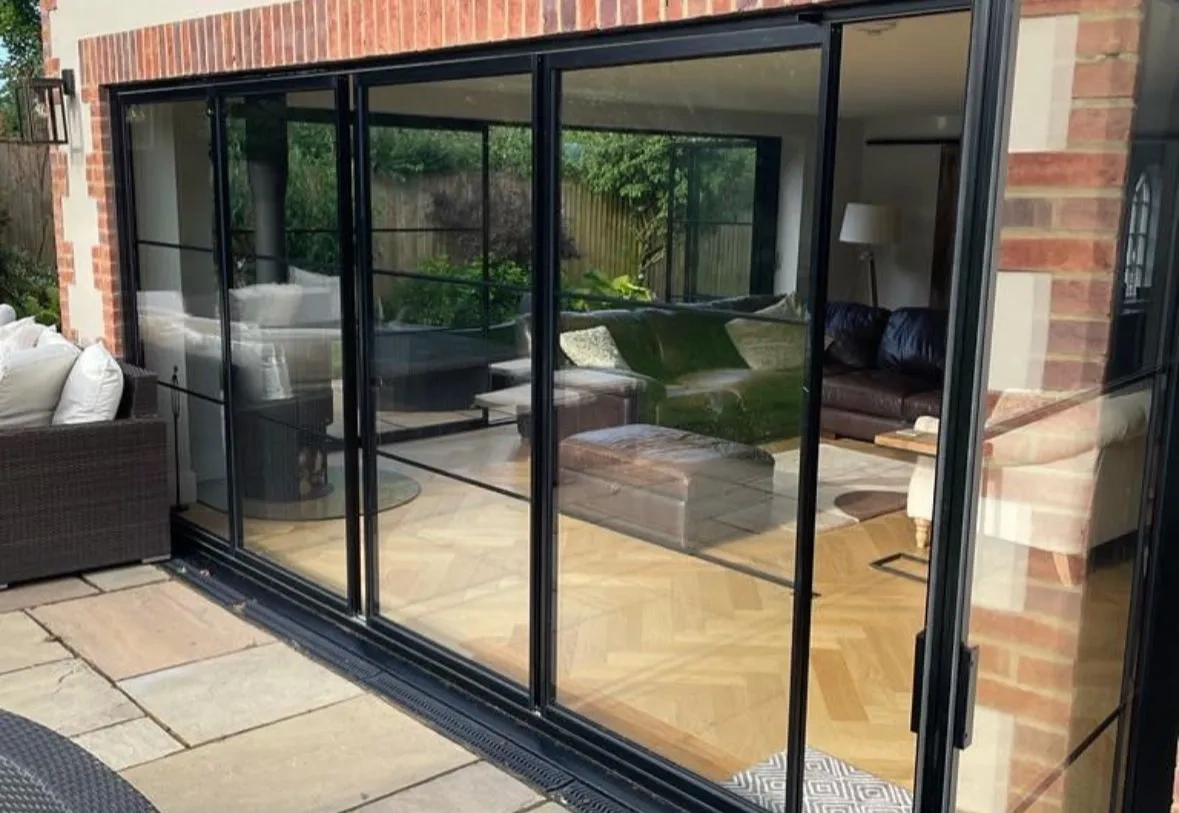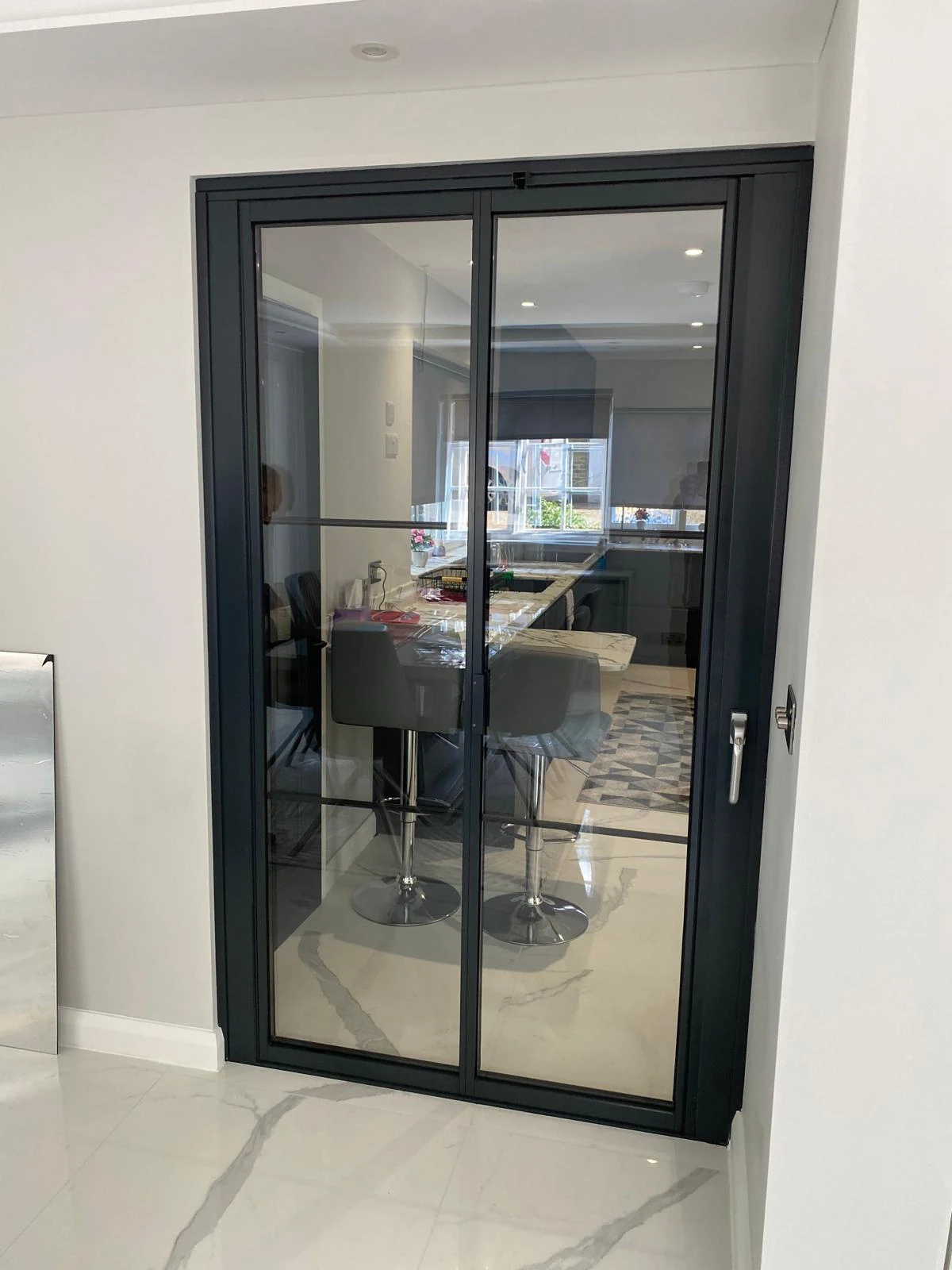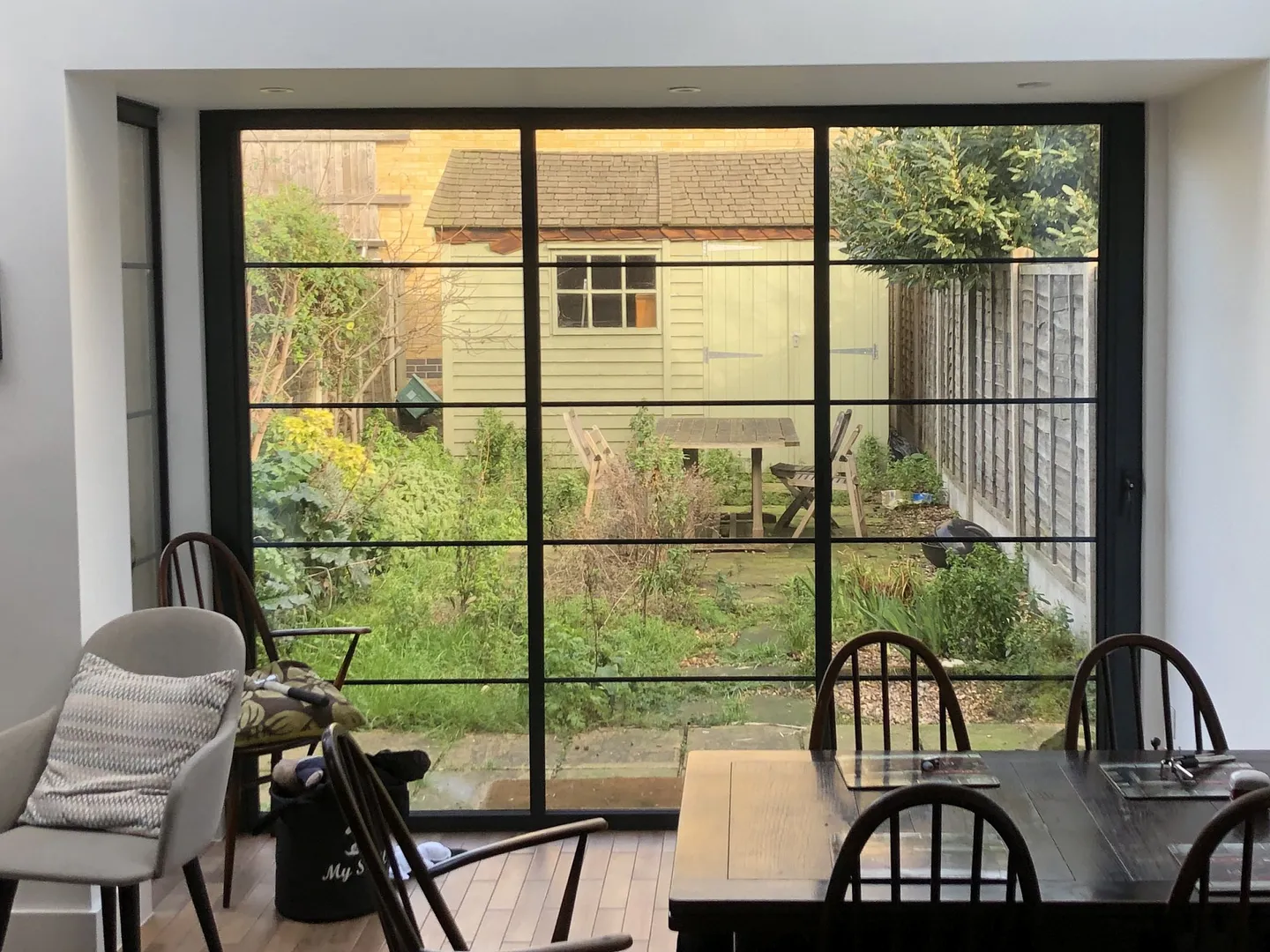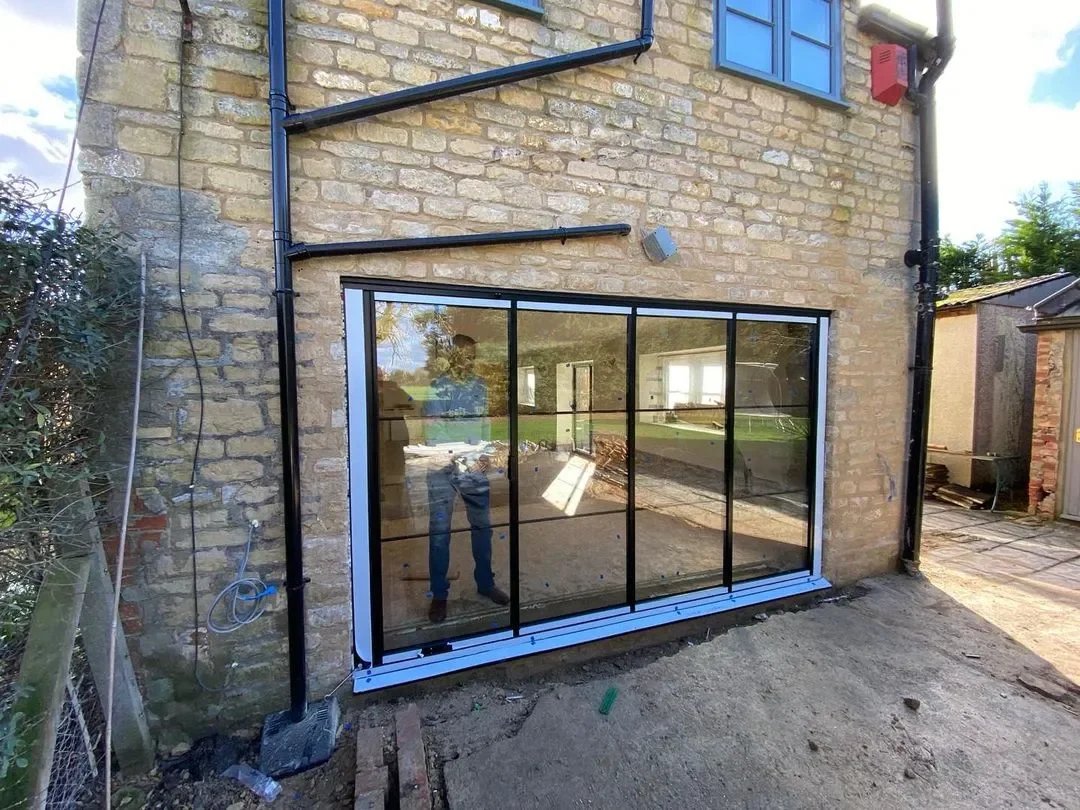Crittall Style Bifold Doors: Design Guide and Style Tips
Table of Contents

What Makes a Door “Crittall Style”
Metal-framed bifold doors with slim, industrial sightlines have grown from a niche design choice into a sought-after option for modern British homes. Crittall style bifold doors blend the clean lines and sharp angles of traditional steel doors with the flexibility of bi-folding doors, creating a bold architectural statement that works in both period properties and new builds.
The Architectural Origins
Britain’s industrial heritage shaped the development of steel look doors in the late Victorian era. Manufacturing advances in metalwork during the 1800s led to slimmer, stronger window and door frames that could support larger glass panels. The distinctive grid patterns and dark frames that characterise modern crittall style bifold doors emerged from these industrial roots, where function dictated form in factory and warehouse buildings across the UK.

Design Characteristics
Slim sightlines define authentic bifold crittall doors, with aluminium frames measuring far less in width than standard door frames. The metal construction allows for larger glass panels divided by a geometric pattern of bars.
Modern folding crittall doors maintain these industrial proportions while offering improved thermal performance through advanced aluminium profiles.
Frame Proportions and Patterns
The visual balance relies heavily on precise measurements between frame elements. Linear bars create either horizontal emphasis or vertical rhythm, while panel sizes follow strict proportional rules. The frames themselves feature sharp rather than rounded edges, capturing the utilitarian origins of these steel-framed designs.
Beyond Basic Black
While matt black remains the classic choice for crittall style bifold doors, modern powder-coating techniques open up new possibilities. Dark bronze and graphite finishes offer subtle variations on the industrial theme, while metallic coatings bring warmth to contemporary spaces. Raw metal finishes like brushed steel pay direct homage to the industrial heritage, though they require more upkeep than powder-coated alternatives.
Creating Visual Impact With Crittall Style Bifold Doors
Striking architectural features demand thoughtful placement and styling to reach their full potential. Crittall style bifold doors stand out for their strong geometric patterns and clean lines, making them natural focal points in any room they occupy.

Room Divider Layouts
Open-plan living spaces benefit from flexible zoning options that maintain visual connections between areas. When used as bifold room dividers, crittall style bifold doors create distinct spaces while preserving sightlines and natural light flow. Placing these doors between a kitchen and dining area allows you to separate cooking smells and noise when needed, while keeping the space open for entertaining. The characteristic black frames draw the eye upward, emphasising ceiling height and creating a sense of architectural rhythm that ties different zones together.
Glass Panel Configurations
Panel arrangements influence how spaces feel when the doors are open or closed. Larger glass panels suit minimalist interiors, while smaller panes with more frequent glazing bars echo traditional heritage doors. The configuration you choose shapes how light moves through your home and determines the visual weight of the installation.
Making Small Spaces Work
Compact rooms gain a sense of spaciousness through strategic door placement. Folding crittall doors expand the visual boundaries of smaller spaces by connecting them to adjacent rooms or outdoor areas. By replacing solid walls with these glazed panels, confined areas feel more expansive without sacrificing privacy or thermal comfort. Dark frames create depth perception, drawing the eye through to the space beyond.
Strategic Door Placement
Heritage aluminium bifold doors require careful positioning to achieve the right balance of light and privacy. Living spaces oriented toward private gardens or courtyards offer ideal locations for crittall style bifold doors, framing outdoor views while maintaining security. Morning rooms and east-facing spaces particularly suit these installations, as the geometric patterns cast striking shadow plays across interior surfaces throughout the day.
Natural light patterns guide optimal placement decisions. South-facing installations of crittall style bifold doors flood spaces with daylight but may need external shading to prevent overheating. North-facing positions provide consistent, glare-free illumination that highlights the doors’ architectural qualities.
The relationship between door location and interior circulation paths shapes daily living patterns. Corner installations of bifold crittall style doors create dramatic sight lines through multiple spaces, while central positions serve as natural gathering points. Kitchen-to-garden connections work particularly well, allowing the cooking space to extend outdoors during warmer months.
Door configurations should respond to your existing architecture. Period properties often benefit from symmetrical arrangements that mirror original features, while contemporary homes can experiment with asymmetric layouts. The strong vertical lines in crittall style bifold doors complement traditional cornicing and dado rails, building a bridge between historic and modern design elements.
Styling Around Crittall Style Bifold Doors
Powerful architectural features need balanced interior styling to create cohesive spaces. Crittall style bifold doors bring strong geometric lines and industrial character that can guide your wider design choices, from furniture selection to lighting schemes.
Art and Display Options
Large-scale artwork commands attention when mounted near crittall style bifold doors, creating a gallery-like atmosphere. Abstract pieces with strong horizontal or vertical elements mirror the doors’ geometric patterns, while softer, organic forms provide visual contrast. Sculpture placement demands careful attention – positioned thoughtfully, three-dimensional pieces cast interesting shadows through the glazing bars as natural light shifts throughout the day.
Wall-mounted collections take on new depth when arranged around external folding doors. The metal frames act as a backdrop that highlights the forms and textures of displayed objects. Photography displays particularly suit these arrangements, with black and white prints echoing the industrial aesthetic of the frames.

Plant Selection and Placement
Living elements soften the angular presence of bifold crittall doors through organic shapes and movement. Tall, architectural plants like bird of paradise or fiddle leaf figs complement the strong vertical lines while adding natural texture. Trailing plants positioned near the top of the frames create gentle cascades that contrast with the rigid geometry below.
Growing climbers and vines along exterior walls near crittall style bi fold doors bridges the gap between inside and out. These green elements frame views through the glass while connecting your interior styling with the garden beyond. Hardy evergreen varieties maintain this effect year-round, their foliage providing a living curtain that shifts with the seasons.
Seasonal Styling
Changing natural decorations with the seasons brings fresh energy to spaces featuring folding crittall doors. Spring branches, summer grasses, autumn foliage, and winter berries each offer distinctive ways to style around these architectural features. Natural materials complement the industrial character of the doors while adding warmth and texture.
Lighting Design
Layered lighting reveals different aspects of crittall style bifold doors as day turns to night. Wall-mounted spotlights cast prominent shadows from the frame patterns, while hidden LED strips wash light across the glass panels. Floor lamps positioned near the doors create pools of illumination that highlight specific zones within open-plan spaces.
The black frames of period property installations produce striking silhouettes when lit from behind. Exterior lighting placed strategically near these doors extends their visual impact after dark, turning the glass panels into mirrors that reflect interior spaces. Dimmer systems allow you to adjust the atmosphere as needed, from bright task lighting to subtle evening ambiance.
Task lighting deserves special attention in spaces divided by these doors. Reading nooks and work areas benefit from adjustable lighting that prevents glare on the glass panels. Pendant lights suspended near the doors should be chosen carefully – their forms become part of the view through the glazing, visible from multiple angles.
Mixing Old and New With Crittall Style Bifold Doors
Modern architectural elements can complement heritage architecture when integrated thoughtfully. Crittall style bifold doors introduce contemporary industrial character while respecting traditional building features through careful material selection and design details.
Period Property Integration
Listed buildings and conservation areas present unique challenges when installing bi-fold doors. Original features like cornicing, ceiling roses, and dado rails set the context for new additions. Crittall style bifold doors echo Victorian industrial architecture, making them a historically appropriate choice for period renovations. The slim frames and precise geometry pay homage to traditional manufacturing techniques while offering modern performance.
Timber mouldings and architectural details gain new purpose when paired with folding crittall doors. Original skirting boards can run smoothly into door frames, creating visual continuity between old and new elements. Floor materials bridge these transitions – reclaimed tiles or restored wooden boards extend beneath the doors, tying spaces together through authentic materials.
Preserving Character
Original features near compact bifold doors need protection during installation. Stone thresholds, decorative tiles, and wooden flooring require careful handling to maintain their integrity. Modern track systems can be adapted to work with uneven period floors, preserving original materials while ensuring smooth operation.
Balancing Design Elements
Heavy Victorian furniture takes on new life alongside crittall style bifold doors. Ornate wooden pieces contrast beautifully with sleek metal frames, while antique mirrors reflect and multiply the geometric patterns. Traditional upholstery fabrics in rich textures prevent industrial elements from dominating period rooms.
Wallcoverings play a vital part in marrying different styles. Heritage patterns in muted colours complement the strong lines of crittall folding doors without competing for attention. Traditional wallpapers featuring subtle geometric elements create links between architectural periods, while plain painted walls let original features speak for themselves.
Window dressings require careful thought when working with bifold crittall style doors. Heavy curtains can overwhelm slim door frames, while minimal blinds might look out of place in ornate rooms. Roman blinds in traditional fabrics offer one solution, providing privacy without hiding architectural details.
Materials
Original building materials establish the foundation for integrating crittall style bifold doors. Exposed brick walls gain industrial authenticity from black door frames, while painted plaster creates a quieter backdrop that highlights the doors’ geometry. Natural stone adds textural depth that bridges historical periods.
Period metalwork deserves special attention when adding new architectural elements. Original door furniture, radiators, and light fittings can inform the finish choices for new installations. Aged brass or bronze hardware on crittall style bifold doors picks up patina from existing metalwork, creating material connections across centuries.
Paint colours wield enormous influence over how successfully modern doors sit in period settings. Strong period colours ground contemporary additions in historical context, while neutral heritage shades let architectural details take centre stage. Traditional paint finishes like limewash or distemper maintain authentic character when used near new door installations.
Technical Design Choices for Crittall Style Bifold Doors
Design details shape how these doors look and perform in your space. Each element, from glazing bars to handles, contributes to the overall aesthetic and usability of crittall style bifold doors.

Glazing Bar Configurations
Integral bars define the visual character of many bifold crittall doors. Horizontal arrangements emphasise width and create a more contemporary feel, while vertical patterns draw the eye upward and echo traditional window designs. The spacing between bars requires precise calculation – too wide and the industrial aesthetic is lost, too narrow and the views become cluttered.
Metal bifold doors often feature asymmetric bar patterns that add visual interest without compromising views. Off-centre arrangements can direct attention toward specific garden features or architectural elements. Upper glazing sections might incorporate smaller panes for period authenticity, while lower sections use larger panels for clearer views.
Glass Options and Effects
Clear glass shows off the geometric framework of crittall style bifold doors, but other options open up new design possibilities. Reeded glass adds texture while maintaining light flow, and works particularly well in bathroom or kitchen installations where privacy matters. Tinted options reduce glare without darkening spaces, though they alter the appearance of the characteristic black frames.
Laminated glass brings additional benefits beyond safety requirements. Acoustic dampening properties improve sound isolation between spaces, particularly valuable when crittall style folding doors separate living areas from noisier zones. Solar control coatings prevent overheating without compromising the doors’ industrial aesthetic.
Thermal Performance
Double glazing systems in modern bifold crittall doors balance thermal efficiency with authentic proportions. Low-iron glass improves clarity while reducing the green tinge common in standard glazing. Warm edge spacer bars, painted to match frame colours, maintain clean lines at panel edges.
Hardware Selection
Handle designs merit careful attention on folding crittall doors. Lever handles in matt black offer practical operation while maintaining clean lines. Magnetic catches provide smooth operation without visible hardware, though period-appropriate locksets might better suit heritage properties.
Hinges and running gear need equal design consideration. Exposed hinges celebrate mechanical elements, adding industrial authenticity. Hidden mechanisms offer cleaner lines but may compromise the utilitarian aesthetic that makes these doors distinctive.
Frame Finishes
Powder-coated finishes on crittall style bifold doors demand precise application to maintain crisp edges and even coverage. Textured coatings hide minor imperfections but change how light plays across the frames. Metallic finishes require additional maintenance yet reward with rich visual depth that shifts through the day.
Surface preparation techniques influence long-term appearance. Multi-stage treatments improve adhesion and prevent micro-bubbling that could spoil smooth surfaces. Edge finishing deserves particular attention where frames meet glass – sharp, clean lines exemplify quality manufacturing.
Track Systems
Floor-mounted tracks provide stability for larger installations but require careful integration with flooring materials. Concealed options hide mechanical elements while maintaining smooth operation. Threshold details need special attention where different floor levels meet – ramped profiles improve accessibility without compromising weather protection.
Overhead track designs suit spaces where floor channels prove impractical. Loading calculations must account for the full weight of glass and frames to prevent sagging. Heavy-duty rollers ensure reliable operation while maintaining the characteristic quiet movement expected of high-quality installations.
We’d Love to Help You
Vision Glass Doors is a designer, manufacturer, and installer of premium door systems. We are a family run business with over 20 years’ experience and 5,000 installations across the UK.
Our leading range of door systems include Ultra Slim – Slide and Turn Doors, Slimline Sliding Patio Doors and Frameless Glass Doors. Suitable for various internal and external applications, they are applicable to residential and commercial projects.
Click Quick Quote Online for a free quotation within 24 hours. Alternatively, call or email us on 01582 492730 or at info@visionglassdoors.co.uk.

